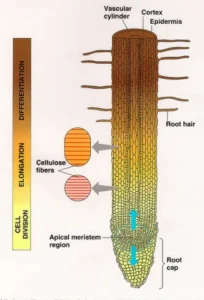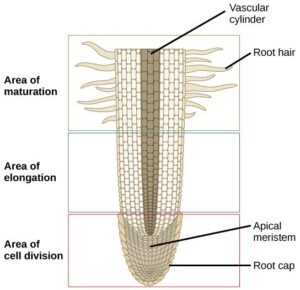Back to: Botany 300 Level
Hello, my brilliant friend! I hope you’re having a fantastic day! Have you ever pulled out a young plant and noticed tiny hair-like structures on its roots? Or maybe you’ve wondered how roots know where to grow and how they push through the soil without getting damaged. Well, today, we’re going to learn about the root cap, root hairs, and the different zones of growth in a root. This is where all the magic of root development happens!
Root cap, root hairs, and zones of growth
Root Cap: The Root’s Protective Helmet
Imagine you’re playing football. Would you run onto the field without a helmet? Of course not! The root cap is like a helmet for the root tip. It is a small, tough structure at the very tip of the root that protects the delicate growing cells from damage as the root pushes through the soil.
Functions of the Root Cap:
Protection: Prevents damage to the root tip.
Lubrication: Releases a slimy substance (mucilage) that helps the root glide smoothly through the soil.

Gravity Detection: Contains statocytes, which help the root grow downward (gravitropism).
Without the root cap, roots would easily get damaged and stop growing properly!
Root Hairs: The Water and Nutrient Absorbers
Have you ever seen a sponge soak up water? Root hairs work in the same way! These are tiny, hair-like extensions that increase the surface area of the root, allowing it to absorb more water and nutrients from the soil.
Characteristics of Root Hairs:
They are single-celled structures.
They grow from the epidermis of the root.
They are short-lived and constantly replaced.
Functions of Root Hairs:
Absorb water and minerals from the soil.
Help anchor the plant firmly in the ground.
Without root hairs, plants would struggle to get the nutrients they need to grow!
Zones of Growth in a Root
Roots don’t just grow randomly. They grow in three distinct zones, each with a special function:
Zone of Cell Division (Meristematic Zone)
Located just behind the root cap.
Contains actively dividing cells from the apical meristem.
This is where new root cells are produced.
Zone of Elongation
Newly formed cells increase in size, making the root grow longer.
No new cells are formed here—only cell enlargement happens.
Zone of Maturation (Differentiation Zone)
Cells become specialized into different tissues like xylem, phloem, and epidermis.
Root hairs develop here, increasing water absorption.

Each zone plays a vital role in ensuring the root grows deeper into the soil and absorbs nutrients efficiently!
A Simple Story to Understand This Concept
Imagine you’re building a tunnel underground:
You wear a helmet (root cap) to protect your head.
You dig the tunnel deeper (zone of cell division) by breaking the soil.
You stretch your body (zone of elongation) to move forward.
Finally, you set up tools (root hairs) to collect food and water.
This is exactly how roots grow and function!
Summary
The root cap protects the root tip and helps it grow downward.
Root hairs absorb water and nutrients and help anchor the plant.
Roots grow in three zones: cell division, elongation, and maturation.
Each zone plays a unique role in root development and function.
Evaluation
- What is the main function of the root cap?
- How do root hairs help plants absorb water?
- Which zone is responsible for making the root longer?
- What role do statocytes play in the root cap?
- Why do root hairs constantly get replaced?
You are doing an amazing job! Now, the next time you see a root, you’ll know exactly how it grows and functions! Keep learning with Afrilearn, and I’ll see you in the next exciting lesson. Stay curious and keep growing!
